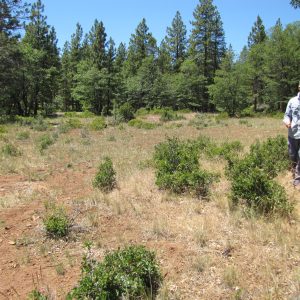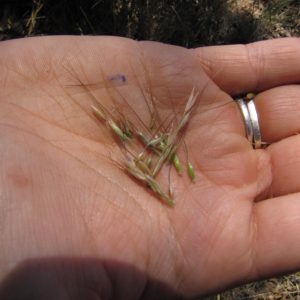This will be my last post for the 2013 season at the BLM Mother Lode field office. I may return next Spring if funding is in place. The government shutdown was an unexpected disruption in my work schedule but luckily most of our major projects such as seed collecting and rare plant monitoring were done before the shutdown took place. The seasonal shift is in full swing. The summer heat has all but dissipated and snow graces the high Sierra peaks. The patches of black oak at Pine Hill Preserve (PHP) have taken on beautiful fall colors.
Since the shutdown ended I have finished mounting and labeling all of the herbarium specimens collected in the spring and early summer, and added them to the PHP herbarium. Deciding on how to place the specimens on the herbarium paper is an artistic process, and care must be taken not to damage them as they are glued down. I enjoyed the slow, methodical pace of this task.
Yesterday I was able to attend a fascinating forum called the Ecology and Management of Medusahead and Barb Goatgrass on California Rangeland. This was at the University of California Sierra Foothill Research and Extension Center, a property replete with research projects on grazing, weeds, oak recruitment, and more. Medusahead and Barb Goatgrass are undesirable exotic grasses that have spread across California at an incredible rate, and both occur on Mother lode Field office land. This event had around 100 people, including professors and researchers, UC extension agents, NRCS range and soil scientists, restoration ecologists, and of course ranchers. A multitude of data was presented on using tools such as fire, herbicide, and high intensity grazing to manage these grasses.
The internship has been great and I have learned a lot. I have enjoyed working for my mentor Graciela. She has been kind, patient, extremely generous, and willing to answer all of my questions. It has been interesting to hear about her experiences of working in myriad locations such as Mexico, Colorado, and California. Since I have been working almost exclusively at PHP, I have gained insight into what goes into managing a small (for BLM standards) preserve with rare plant species, including federally endangered plant species. PHP is a partnership between many county, state, and federal agencies. Graciela is an expert at working with different agencies and understanding legal and bureaucratic intricacies. The Mother Lode field office is unique in that almost a third of its funding comes from outside sources (i.e. not the Department of the Interior). This funding is what runs special areas like PHP and Cosumnes River Preserve, and it comes from proactive action such as grant writing. In this time of budget cuts, Graciela and others at this office have convinced me that important conservation projects can still go forward.
Working here has also made me think a lot about plant monitoring. We have implemented various monitoring methods on the rare plants and fuel breaks at PHP. I have thought about the purpose of plant monitoring and how I would go about designing a plant monitoring project, if it were up to me. I have lots to learn in that regard but this summer has been a big step.
I enjoyed the opportunities to explore areas of this field office besides PHP, particularly seed collecting and raptor surveying at the Cosumnes River Preserve. Parts of CRP are riparian jungles full of birds and other wildlife that provide a picture of what the Central Valley may have looked like before the levees, farms, subdivisions and highways. I also enjoyed other opportunities such as leading native plant walks, going to workshops, and participating in river monitoring.
One of my favorite days was pulling yellow star thistle at the Red Hills in Tuolumne County. That is generally not a great job, especially in the middle of summer, but on that day Poor Man’s Gulch involved little star thistle. While slowly walking the riparian margin with eyes out for star thistle I couldn’t help but be blown away by the contrast between the parched, stunted vegetation of the serpentine uplands and the verdant, explosive greenness of the creek, not to mention the nearly complete lack of any signs of human activity. It’s days such as that that attract me to a job like this and… well… Edward Abbey put it better than me (I’ll leave out the obligatory vindictive end of his quote for the purposes of this blog):
“One final paragraph of advice: do not burn yourselves out. Be as I am – a reluctant enthusiast….a part-time crusader, a half-hearted fanatic. Save the other half of yourselves and your lives for pleasure and adventure. It is not enough to fight for the land; it is even more important to enjoy it. While you can. While it’s still here. So get out there and hunt and fish and mess around with your friends, ramble out yonder and explore the forests, climb the mountains, bag the peaks, run the rivers, breathe deep of that yet sweet and lucid air, sit quietly for a while and contemplate the precious stillness, the lovely, mysterious, and awesome space. Enjoy yourselves…”
With that in mind I am soon going to the Dominican Republic to visit my brother who is doing the Peace Corps, before I make my next move.
Joe Broberg































